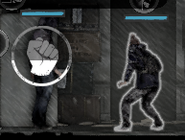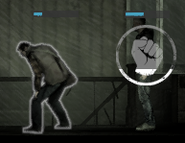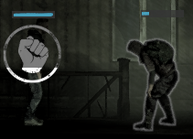Overview
This War of Mine has a fairly basic combat system. Interactive combat only occurs while scavenging and the player only needs to control one character. Scavenging characters can use melee weapons or firearms against civilians, thugs, and heavily armed soldiers. Melee weapons can be used to stealthily attempt a backstab. Firearms combat incorporates a cover system to mitigate damage from return fire.
Combat is driven by first clicking on a weapon in the top-left corner of the game screen; you must choose to leave Scavenge mode to initiate an attack. After that, click on the "attack" icon next to a target, represented by a white fist, knife, or cross-hairs, depending on your weapon.
Combat Weapons
Fists: Unarmed survivors will be forced to use their bare fists when scavenging and defending the shelter. Scavenging survivors can attempt to punch adversaries, though─depending on each individual survivor─they will typically miss or inflict very low damage. Survivors defending the shelter unarmed will typically get wounded and have supplies stolen from the shelter. Roman has the distinct advantage of being able to wait in hiding spots and kill passing enemies with his bare hands.
Melee weapons: Including Crowbar, Shovel, Hatchet, and Knife.
Firearms: Including Pistol, Shotgun, Assault Rifle, and Scoped Assault Rifle. All ranged weapons in the game use Ammunition when fired. In-game Ammunition is a simplified representation and is cross-compatible with all firearms regardless of the implied caliber or cartridge that would be used in real life. For example, the Pistol uses the same unit of ammunition when fired as does the Shotgun (though the Shotgun is more powerful). The Assault Rifle uses 3 Ammunition when fired, whereas all other weapons will only use 1.
Cover: after entering combat mode, icons representing areas of cover will be revealed. Survivors can use cover for a defensive bonus against firearms.
Combat Proficiency
There are 5 tiers of Combat Proficiency among the survivors. All characters were unarmed and the test target is Matey and Emil, who have a same white area scale for the same character, although Matey was equipped both, a gun and a knife, while Emil had only knife.
- See also: Combat Proficiency
Melee Hit Chance (current hypothesis)
The chance to successfully attack an adversary in melee combat depends on the attacking character's Combat Proficiency, weapon used, the opponent's Combat Proficiency, and the opponent's melee weapon (if any).
While in melee combat mode, the melee hit chance is represented as a white overlay that overlaps the attack icon. The amount of overlay determines chance to hit. The character's fighting ability and weapon used determines the damage. Possessing a firearm while in melee combat mode does not affect the white overlay.
In summary, the amount of white overlay depends on several factors:
- A character armed with a melee weapon increases the overlay.
- A character's combat proficiency can increase or reduce the overlay.
- A target armed with a melee weapon reduces the overlay. This includes opponents with both guns and knives equipped. Opponents that only have a gun will have a larger overlay than opponents who wield only a knife.
- Unarmed opponents, like most civilians, have the largest to full overlay. They less likely fight back and tend to run away when being attacked. Armed civilians have the same overlays as bandits and military personnel.
Old or sick civilians are less likely to fight back, such as the sick wife at the Quiet House or sick father at the Garage .
During each melee attack there is a chance that an opponent can successfully defend against the attack or get hit. To calculate hit chance, the game most likely uses a Random number generator. This number is compared against a base chance (consisting of Melee Proficiency, weapon used, opponent's Melee Proficiency, opponent's melee weapon used, etc.) to determine if a successful attack occurs. For example, soldiers tend to evade attacks more often than civilians, so they must have a different base chance to-hit. Whether or not the attack is successful must be calculated using a random number.
Some characters have a higher Melee Proficiency than others, which can affect the chance to hit.
Firearms Hit Chance
Similarly, equipping a firearm will create an overlay to appear over the cross-hairs reticule. It is implied that this overlay also represents the hit-chance.
Health
Some characters have higher health than others, thus making them better choices in combat. Boris takes 5 hits to die by Emil (who is armed with a knife), while Roman takes 4 and others take 3 hits. However, health doesn't modify the white area scale of the attack icon.
Some civilians have lower health than other in spite of having full health bar, such as the old couple at the Quiet House.
Ambush
Orange icon that represents stealth-ambush.
Attacking an unaware enemy, from behind or from a hiding spot, will replace the melee icon or fist icon with an orange stabbing symbol. Clicking this icon allows you to perform an ambush which can instantly kill or at least critically injuring an adversary in full health.
The game automatically equips the strongest melee weapons while scavenging in order:
Crowbar is the weakest melee weapon, which deal much less damage than others in both direct melee combat and ambushes.
The information below is tested for all characters:
Summary Table of Ambush Instakill Capabilities:
| Characters | Stealth-Ambush | Backstab | Note |
| Anton | Yes | No | Unable to do so with Crowbar |
| Arica | Yes | Yes |
Can instakill with bare fists when stealth-ambushing, but not in backstabbing with bare fists and crowbar. |
| Boris | Yes | Yes | Can instakill with bare fists when stealth-ambushing, but not in backstabbing with bare fists and crowbar. |
| Bruno | Yes | No | |
| Cveta | No | No | |
| Emilia | Yes | No | |
| Katia | Yes | No | Unable to do so with Crowbar |
| Marin | Yes | No | Unable to do so with Crowbar |
| Marko | Yes | No | |
| Pavle | Yes | No | |
| Roman | Yes | Yes | Can instakill with bare fists when stealth-ambushing, but not in backstabbing. |
| Zlata | Yes | No | Unable to do so with Crowbar |
Stealth-Ambush
Stealth-ambushing refers to the act of attacking the unaware target in melee when he/she walks/runs past the hiding spot that you are in. It is the strongest combat action in game which can almost guarantee to instakill your target. All locations in game─even the most dangerous ones─can be cleared with stealth-ambushes well managed by wisdom and skills, without deploying firearms, risking attracting adversaries to swarm you and wasting precious ammunition.
- All characters can instakill when stealth-ambushing with a weapon stronger than Crowbar, except Cveta, who cannot perform instakill under any circumstances.
- Roman, Boris, Marko, Arica, Emilia and Pavle are capable of instakilling with any weapons in stealth-ambushes.
- Roman, Arica and Boris can instakill when stealth-ambushing, even with bare fists.
Backstab
Backstabbing refers to the act of sneaking behind your target and attack them in melee from behind. Unlike stealth-ambushing, backstabbing deals much less damage than the former, this makes backstab instakill almost impossible on most characters. Roman, Arica and Boris are the only exceptions.
- Most characters cannot instakill with backstab.
- Roman is capable of backstab instakill with any weapons except bare fists.
- Arica and Boris are capable of backstab instakill with any weapons except bare fists and crowbar.
- Police Officer cannot instakill with backstabbing, but the damage dealt is enough to tactically incapacitate the target immediately if done with a hatchet, effectively leaving the target unable to combat and begs for mercy.
Running before backstabbing usually leads to failure, as the footsteps alerts the target. The only exception is on Arica, whose special ability 'Sneaks Quietly' enables her to produce minimal noise in all actions, thus enabling her to run behind the target without being detected. Therefore, she becomes the best choice for players who like to clear maps with backstabs quickly.
Additional Information
- Two handed firearms, such as the shotgun, assault rifle, and scoped rifle increase character movement speed by about 20%. Two handed melee weapons such as the shovel and hatchet don't seem to increase movement speed despite being held with two hands by the survivors. It is best used with a well fed (if possible content) Pavle, resulting in a sprint of ridiculous speed.
- A good tactic is to enter a hiding spot and monitor NPC movements, if an NPC appears above or below you one floor you can lure them to the hiding spot by making noise such as running around the spot and then hiding until the NPC comes over to investigate. Note that this tactic doesn't work for Arica, since she's too quiet.
NPC Tactics
NPCs seem to have a well programmed AI that sometimes completely catches the survivor off guard, while sometimes several of them walk into the same death trap over and over again. Some notable behaviour can be witnessed, such as:
- Surrounding awareness - Hostile NPCs will always investigate the noises made by the player's survivor if it reaches them. Noises can be seen as shockwaves, and certain actions such as backstabs, gunshots, breaking open containers with crowbars and chopping furniture produce the highest amount of sound. Even if some sound effects (such as doors opening and closing) are relatively loud, they seem to not produce any noise at all unless kicked/charged open.
- Visual awareness - NPCs always close doors behind themselves if in a calm state. Neutral/friendly NPCs will panic and alert everyone if it sees a door left open by the survivor. Hostile NPCs seem to have a 50:50 chance of staying calm (then closing the door), or raising the alarm. If a single NPC that has closed a door sees another open door, it will raise the alarm without hesitation. Witnessing a murder or finding a fallen friend will make them alert everyone else and attack the survivor on sight.
- Patrolling - NPCs usually have a fixed patrol pattern, often triggered when the player's survivor enters an area. Neutral/friendly NPCs alert the survivor that they have been spotted and will urge him to leave the area considered private. Hostile NPCs will yell at the survivor and attack on sight, if the survivor manages to hide unseen they seem to be scripted to pass by the players hiding spot, giving the player an obvious chance for retaliation. The exact "hostile" patrol time seems to be around 1 or 2 ingame hours, the NPCs seem to return to their default patrol route after that time.
- Communication - Lone NPCs usually alert or even bring friends to search for the survivor. A good tactic for splitting them up is hit and run, generally killing the last person in the patrol and then running/hiding until they spread out.
- Surrendering - NPCs that have been severly/lethally wounded will stop combat and beg for mercy, usually giving up on combat but also sometimes attempting a final stand.
- Scripted sequences - NPCs in some occasions have a scripted behaviour, this includes intentionally walking by a survivor's hiding spot if in a "hostile" patrol, not falling for the same hiding spot as their dead friend to the extent of floating down an open wide building (notably the Brothel). If on a "neutral" patrol route they might stop just before the survivor's hiding spot for a few seconds then continuing its patrol or going in the other direction, they wait in front of doors what seems indefinitely until the survivor tries to sneak by, and many other such instances.
Bugs
- After performing a back-stab, clicking to hide will make the scavenger stand still. This is because the backstab animation lasts longer than the actual action. To fix this, click to move after the backstab then click to hide, the character will move a bit then hide normally.
- The above bug might be an intentional way to prevent players from backstabbing an NPC, then quickly hiding again before its friend comes to investigate.
- Sometimes hostile NPCs, like soldiers and thugs, repeat an action over and over and keep standing in that spot instead of patrolling normally. Scavenger must get out of the hiding spot and reveal themselves, forcing them patrol normally. This is dangerous, due to the NPCs gaining advantages.










